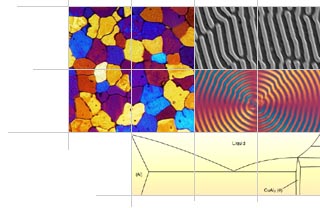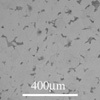Micrograph Library
Browse the libraryAdvanced searchSystemsCompositionsTechniquesKeywordsPhase diagramsHelpPreferencesAbout the micrograph libraryTerms of useContribute micrographs!FeedbackLinksCredits Print this page

Full Record for Micrograph 17

[62 KB]
View micrograph
.. in new window
View micrograph and record
.. in new window
You can also view and download the micrographs on Flickr
- Micrograph no
- 17
- Brief description
- Fe, C 0.1 (wt%), hypoeutectoid alloy
- Keywords
- allotriomorph
 , alloy
, alloy  , austenite
, austenite  , carbon, ferrite
, carbon, ferrite  , hypoeutectoid
, hypoeutectoid  , iron, metal, pearlite
, iron, metal, pearlite  , proeutectoid steel
, proeutectoid steel  , steel
, steel 
- Categories
- Metal or alloy
- System
- Fe-C-X

- Composition
- Fe, C 0.1 (wt%)
- Standard codes
- Reaction
- Processing
- Normalised
- Applications
- Sample preparation
- Etched in 3% nital
- Technique
- Reflected light microscopy
- Length bar
- 400 μm
- Further information
- This is a hypoeutectoid alloy, which has been air cooled from the austenite phase field at 950 °C. The first solid to form is proeutectoid ferrite, its morphology being determined by the cooling rate. At slow cooling rates (furnace cooling) there is sufficient time for the carbon rejected from the austenite to diffuse and equilibrium solidification occurs. With faster cooling the microstructure also depends on the original austenite grain size.
Fast cooling and large grain size favours ferrite forming as Widmanstätten side plates from the grain boundaries. Small grain sizes imply a high number of nuclei and hence the ferrite grows as grain boundary allotriomorphs. In this case air cooling is sufficiently slow to produce allotriomorphic ferrite. The majority of the austenite has changed to ferrite leaving only a small amount to be transformed to pearlite, therefore the microstructure shows large ferrite grains with small islands of pearlite. - Contributor
- Prof T W Clyne
- Organisation
- Department of Materials Science and Metallurgy, University of Cambridge
- Date
- 25/10/01
- Licence for re-use
 Attribution-NonCommercial-ShareAlike 4.0 International
Attribution-NonCommercial-ShareAlike 4.0 International- Related micrographs

